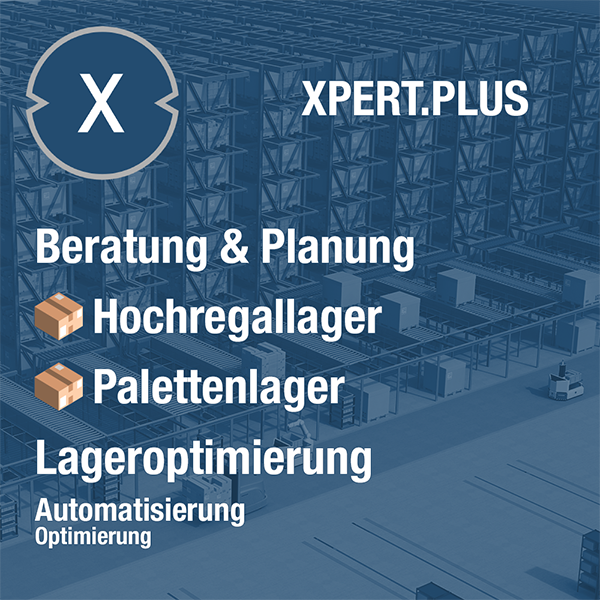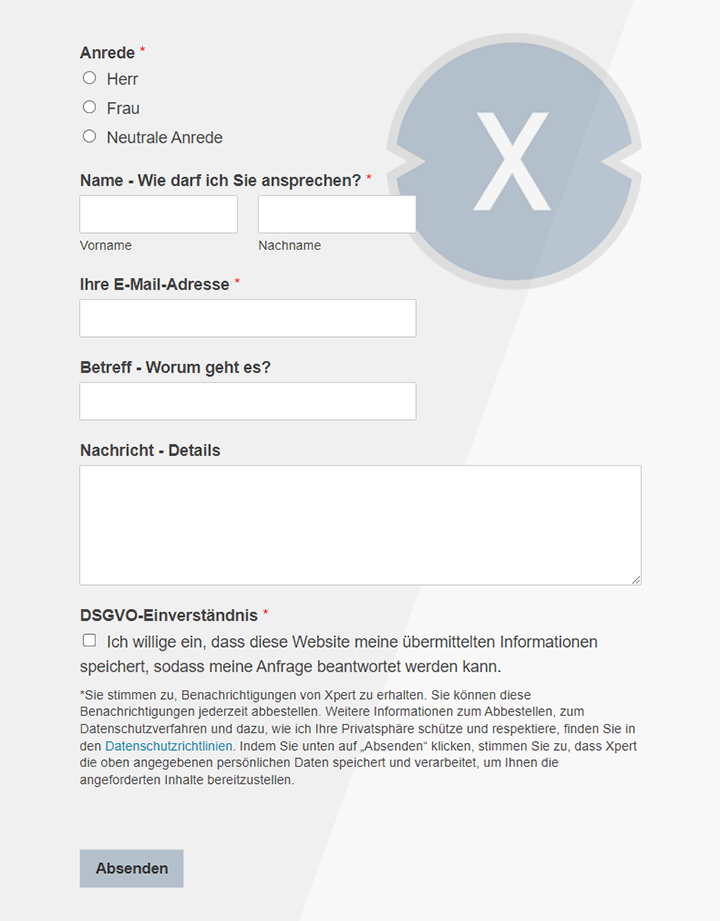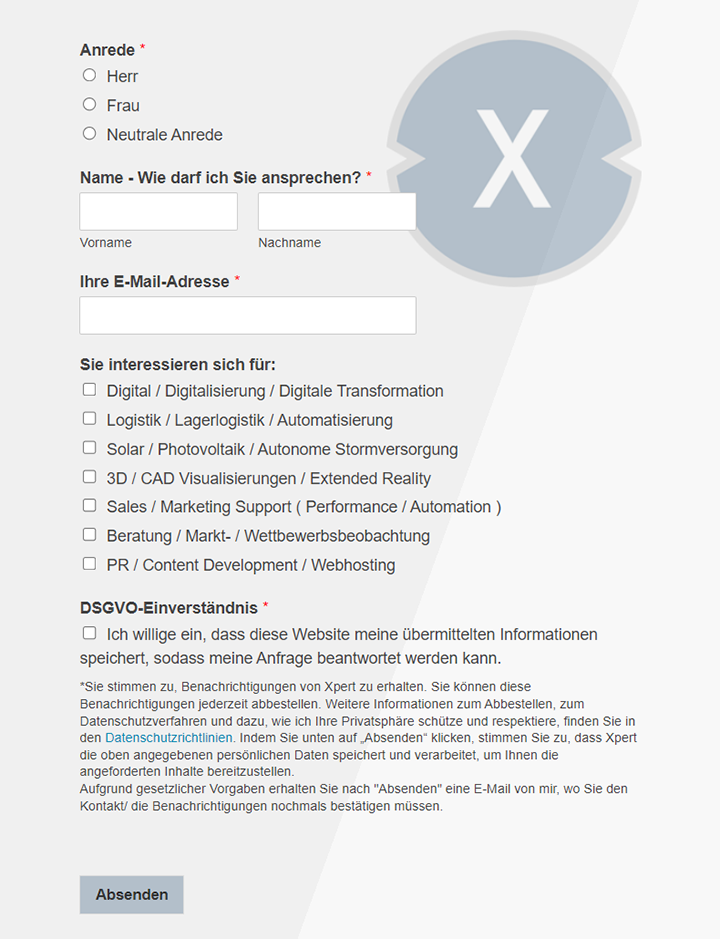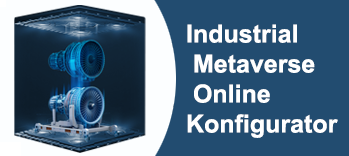GTIN and 2D codes (DataMatrix) – unique product identification in warehouse management: The global GS1 Sunrise 2027 initiative
Xpert pre-release
Language selection 📢
Published on: December 25, 2024 / Update from: December 25, 2024 - Author: Konrad Wolfenstein

GTIN and 2D codes – unique product identification in warehouse management: The global GS1 Sunrise 2027 initiative – Image: Xpert.Digital
GTIN and 2D codes – The future of product identification in warehouse management
The GS1 Sunrise 2027 initiative brings groundbreaking innovations to warehouse management and the entire supply chain. The focus of this initiative is the transition to 2D barcodes and the integration of advanced product information. This change aims to make processes more efficient, transparent and future-proof. Below is a look at how the initiative will revolutionize inventory management.
2D barcodes: A core component of the initiative
2D barcodes, such as QR codes and DataMatrix codes, are at the heart of the Sunrise 2027 initiative. These advanced codes surpass traditional 1D barcodes in many ways:
1. Increased data storage capacity
2D codes can store up to 7,000 characters, making it possible to store comprehensive product information directly in the code. While 1D barcodes only store a GTIN, 2D codes can contain important additional data such as production batches, expiry dates and specific storage instructions.
2. Improved traceability
By storing batch and serial numbers, traceability along the supply chain is significantly simplified. For example, in the event of a product recall, companies can specifically identify affected batches and act.
3. More efficient inventory management
The increased data capacity enables precise inventory management. Warehouse managers can use automated systems to better monitor inventory and proactively plan needs.
With these advantages, the use of 2D barcodes will not only help optimize processes, but also create the basis for new technologies in warehouse management.
GTIN: The basis for product identification remains
Even with the introduction of 2D barcodes, the Global Trade Item Number (GTIN) remains a central element for product identification. The GTIN continues to serve as a unique key that will be embedded in the new barcodes. This ensures that existing systems remain compatible and at the same time can benefit from the expanded possibilities.
Why does the GTIN remain so important?
- Global standardization: The GTIN is established worldwide and ensures uniform identification methods.
- Flexibility: Their integration into 2D codes allows them to be combined with other data elements without losing their original function.
- Future viability: Companies that already work with the GTIN can implement the change more easily and cost-effectively.
Advanced product data: More transparency and control
A key advantage of 2D barcodes is the ability to store extended product data. This additional information is particularly invaluable for warehouse management:
1. Expiry dates
Information about the best-before date (BBD) can be stored directly in the barcode. This makes it much easier to control sensitive goods such as food or pharmaceuticals. Warehouse managers can sort products based on their shelf life and minimize waste.
2. Production batches
Storing batch numbers improves transparency and simplifies follow-up in the event of product recalls or quality issues.
3. Detailed product specifications
Technical data, storage requirements and safety information can also be integrated. This makes handling complex products easier and improves storage under special conditions.
With this expanded data, warehouse management not only becomes more efficient, but also more flexible and sustainable.
Improvements in supply chain management
The introduction of the GS1 standards brings far-reaching benefits for supply chain management. The new technology opens up numerous possibilities, particularly in warehouse management:
1. Increased transparency
With 2D barcodes and extended data, it is possible to seamlessly track the flow of goods along the entire supply chain. This allows companies to react more quickly to disruptions and increase efficiency.
2. Optimized inventory control
Real-time data allows inventory levels to be monitored and optimized more precisely. This reduces excess inventory and prevents shortages.
3. Reducing waste
Accurately tracking expiration dates enables timely use or reuse of products that would otherwise remain unused.
The improved supply chain insights help companies not only reduce costs but also increase customer satisfaction.
Automation and system integration
The Sunrise 2027 initiative promotes increased automation in warehouse management. Modern technologies based on the new GS1 standards offer companies numerous advantages:
1. Integration with existing systems
Warehouse management systems (WMS) can be seamlessly connected to the new standards. This makes implementation easier and increases efficiency.
2. Automated processes
Storage and retrieval processes can be accelerated through automated scans. 2D barcodes allow multiple data points to be captured in a single scan.
3. Reduced need for manual intervention
With expanded data and automated systems, the effort required for manual entries decreases. This minimizes errors and saves valuable time.
This automation not only makes warehouse management more efficient, but also more cost-effective and error-free.
Challenges and recommendations
Despite the numerous advantages, the transition to the new standards also poses challenges. Companies should recognize these in good time and actively address them:
1. Technological implementation
The introduction of new systems and technologies requires investments in software and hardware. Comprehensive planning is essential to ensure a smooth transition.
2. Employee training
The new standards require a basic understanding of 2D barcodes and their usage. Companies should set up training programs to properly train their employees.
3. Internal and external communication
The change not only affects internal processes, but also collaboration with suppliers and customers. Clear communication is key to ensuring everyone involved is on the same page.
4. Recommendation
Companies should start planning and implementing early. Pilot projects can help identify potential challenges and develop effective solutions.
🎯🎯🎯 Benefit from Xpert.Digital's extensive, fivefold expertise in a comprehensive service package | R&D, XR, PR & SEM

AI & XR 3D Rendering Machine: Fivefold expertise from Xpert.Digital in a comprehensive service package, R&D XR, PR & SEM - Image: Xpert.Digital
Xpert.Digital has in-depth knowledge of various industries. This allows us to develop tailor-made strategies that are tailored precisely to the requirements and challenges of your specific market segment. By continually analyzing market trends and following industry developments, we can act with foresight and offer innovative solutions. Through the combination of experience and knowledge, we generate added value and give our customers a decisive competitive advantage.
More about it here:
Efficiency rethought: What the introduction of 2D barcodes means for companies
The globalized economy and the ever-growing demands for transparency and efficiency in supply chains require innovative solutions for product identification and tracking. The GS1 Sunrise 2027 initiative represents a crucial milestone in this regard. From 2027, this initiative will fundamentally change the way products are labeled and recorded in warehouse management. At the heart of this transformation are the expanded capabilities of the GS1 standards, particularly the introduction of 2D barcodes and the continued importance of the Global Trade Item Number (GTIN).
A central aspect of this development is the replacement of traditional 1D barcodes with more advanced 2D barcodes such as QR codes and DataMatrix codes. This innovation is not just a technological advancement, but also has enormous potential for optimizing warehouse processes and the entire supply chain.
The superiority of 2D barcodes in warehouse management
The choice of 2D barcodes as a central element of the GS1 Sunrise 2027 initiative is well considered and based on the significant advantages this technology offers over its predecessors. Unlike 1D linear barcodes, which store information horizontally, 2D barcodes use a matrix-like structure that allows data to be encoded both horizontally and vertically.
This multidimensional storage results in significantly increased data storage capacity. While traditional barcodes are limited to a limited number of characters, 2D codes can hold thousands of characters - up to 7000 characters are possible. This capacity expansion opens up completely new possibilities in warehouse management. Not only basic product information such as the GTIN can be stored, but also detailed information such as serial numbers, batch numbers, expiry dates, production dates and even links to further information on the Internet.
Another key advantage of 2D barcodes is the improved traceability of products. The ability to store batch and serial numbers directly in the code enables complete tracking of the product life cycle. This is particularly important in industries with strict regulatory requirements, such as the food and pharmaceutical industries. In the event of a recall, affected products can be identified quickly and precisely, increasing the efficiency of the recall process and minimizing potential damage.
The expanded data capacity of 2D barcodes also leads to more efficient inventory management. By storing detailed product information directly on the product, inventory levels can be tracked and managed more accurately. This enables more precise demand planning, reduces the likelihood of stock-outs or overstocks and thus optimizes inventory costs. The real-time availability of inventory data obtained by scanning the 2D codes allows companies to respond more quickly to changes in demand and adapt their inventory strategies accordingly.
The central role of the Global Trade Item Number (GTIN)
Even in the age of 2D barcodes, the Global Trade Item Number (GTIN) remains an indispensable element for clear product identification. The GTIN acts as a kind of digital fingerprint for every commercial product and ensures that every product can be uniquely identified worldwide. As part of the GS1 Sunrise 2027 initiative, the GTIN will be seamlessly integrated into the 2D barcodes. It forms the foundation for expanded data options and ensures that even with the introduction of new technologies, the fundamental requirement for smooth global trade is maintained: the clear identification of each individual product. The GTIN therefore enables systems across company boundaries to correctly assign products and exchange information.
Advanced product data for optimized warehouse management
The introduction of 2D barcodes opens up the possibility of storing a variety of advanced product data directly on the product, which is of great use for warehouse management.
Expiration dates are a great example. By storing the best-before date directly in the 2D code, warehouse management systems can automatically generate alerts when products are approaching the expiration date. This enables better control of the flow of goods according to the first-expired-first-out (FEFO) principle and reduces food waste and write-offs.
Storing production batches in 2D code significantly improves traceability. In the event of quality problems or recalls, affected batches can be quickly identified and withdrawn from circulation. This minimizes potential harm to consumers and businesses.
Detailed product specifications such as dimensions, weight, material composition or storage conditions can also be stored in the 2D code. This information enables optimized storage, for example by ensuring that products are stored in the right conditions and that storage space is used efficiently. This detailed information can also speed up the picking processes and reduce errors.
Improved supply chain management through GS1 standards
The GS1 standards and the associated introduction of 2D barcodes and the integration of the GTIN lead to improved supply chain management along the entire value chain.
The increased transparency and visibility throughout the supply chain is a key benefit. The ability to capture and exchange detailed product information in real time gives everyone involved - from the manufacturer to the logistics service provider to the retailer - a better overview of the whereabouts of the products. This enables faster response to supply chain disruptions and optimized planning.
GS1 standards also help ensure necessary inventory levels. With more precise inventory management and improved traceability, companies can better plan their inventory levels and ensure there are always enough products available to meet demand without incurring unnecessary storage costs.
Reducing waste through better inventory control is another important aspect. The ability to track expiration dates and phase out older products first minimizes the risk of products spoiling or becoming obsolete and needing to be discarded. This not only makes economic sense, but also contributes to sustainability.
Automation and seamless system integration
The GS1 Sunrise 2027 initiative and associated standards promote automation in warehouse management and enable improved system integration.
Improved integration with warehouse management systems (WMS) is a crucial factor. Modern WMS can directly capture and process the information contained in the 2D barcodes. This reduces the need for manual data entry and minimizes the risk of errors. Real-time data updating allows warehouse managers to have an accurate overview of inventory levels and the status of goods movements at all times.
The optimized processes for storage and retrieval are another advantage. By scanning the 2D barcodes, products can be identified quickly and efficiently and assigned to the correct storage locations. Picking is also accelerated because the products needed can be found more easily using the information contained in the code.
The reduced need for manual intervention leads to increased efficiency and reduced costs. Less manual work means fewer errors, less time spent and lower personnel costs. Employees can focus on more complex tasks while repetitive scanning and data collection processes are automated.
A strategic step into the future of warehouse management
The move to the enhanced GS1 standards by 2027 is more than just a technology update. It is a strategic move that has the potential to fundamentally improve the efficiency, accuracy and transparency of warehouse management. Companies that start implementing early can secure a competitive advantage and benefit from the numerous advantages. The challenges of the transition should not be underestimated, but the long-term benefits - from reduced costs and minimized waste to improved traceability and customer satisfaction - far outweigh them. The GS1 Sunrise 2027 initiative is an important driver for modernizing supply chains and a crucial step towards smarter and more efficient warehouse management of the future. The integration of 2D codes and the consistent use of the GTIN are not only technological necessities, but rather strategic investments in the competitiveness and future viability of companies in an increasingly complex and globalized world.

Xpert.Plus warehouse optimization - high-bay warehouses such as pallet warehouses consulting and planning
We are there for you - advice - planning - implementation - project management
☑️ SME support in strategy, consulting, planning and implementation
☑️ Creation or realignment of the digital strategy and digitalization
☑️ Expansion and optimization of international sales processes
☑️ Global & Digital B2B trading platforms
☑️ Pioneer Business Development
I would be happy to serve as your personal advisor.
You can contact me by filling out the contact form below or simply call me on +49 89 89 674 804 (Munich) .
I'm looking forward to our joint project.
Xpert.Digital - Konrad Wolfenstein
Xpert.Digital is a hub for industry with a focus on digitalization, mechanical engineering, logistics/intralogistics and photovoltaics.
With our 360° business development solution, we support well-known companies from new business to after sales.
Market intelligence, smarketing, marketing automation, content development, PR, mail campaigns, personalized social media and lead nurturing are part of our digital tools.
You can find out more at: www.xpert.digital - www.xpert.solar - www.xpert.plus
























